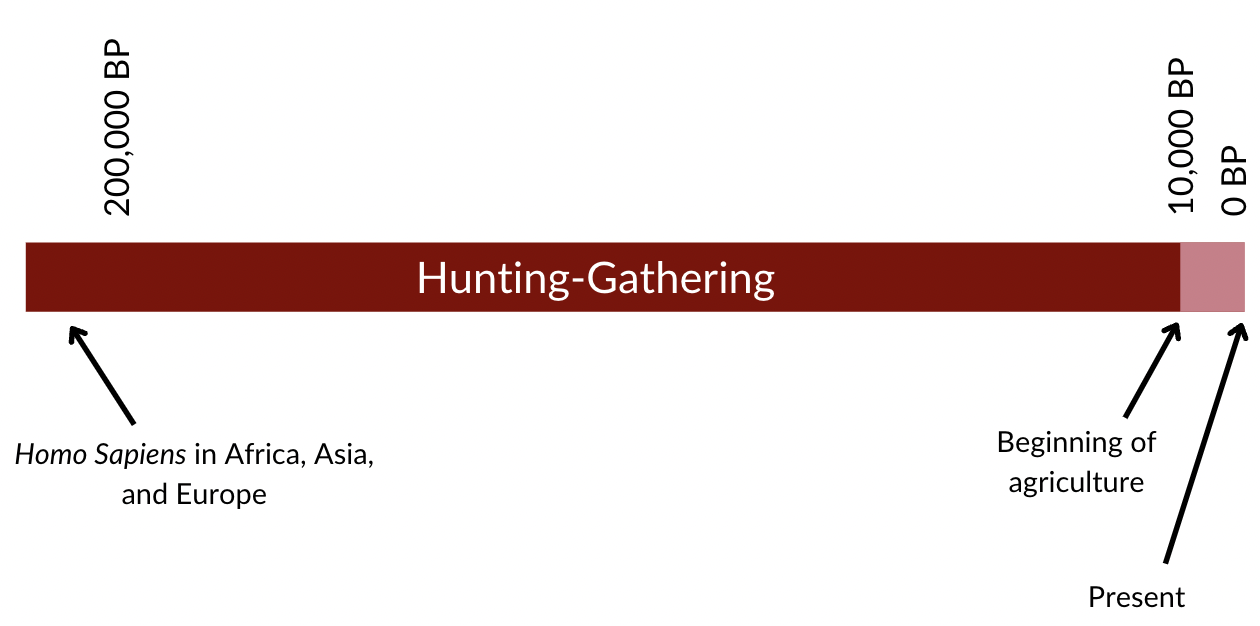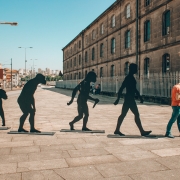Why We Need Exercise: An Evolutionary Perspective
By Maya Shetty
By now, we have all heard that exercise is good for us. But why is this? And if it’s so beneficial, why is it so hard to get up and do it? Nearly 80% of US adults are not meeting The Center for Disease Control(CDC) exercise guidelines, which call for a minimum of 150 minutes a week, or 21 minutes a day. To understand the disconnect between exercises’ necessity and our difficulty doing it, we can refer to evolution and why humans evolved to do it in the first place.
The first humans emerged around 200,000 years ago and, unsurprisingly, their lives looked very different from our lives today. While we complain about having to take the escalators instead of the stairs or when Uber Eats takes too long, our ancestors were running from predators and hunting for prey. In fact, humans survived through hunting and gathering practices for 95% of human history. This means the majority of our evolution was spent living as nomadic hunter-gatherers. Therefore, our bodies and behaviors are adapted to this lifestyle.
 Now, you may be wondering how this translates to exercise in today’s society. Well, as hunter-gatherers, our ancestors’ main advantage was endurance. We are not the strongest or fastest animals out there, so survival was dependent on our ability to outrun our predators and prey. Evolutionarily, we are endurance athletes adapted for consistent, long bouts of physical activity. If this is the case, then why does the average American spend most of their time relatively immobile? This is because we are also adapted for inactivity and energy conservation whenever possible. Thinking again about the hunter-gatherer lifestyle, our ancestors were constantly trying to maintain their energy balance – food intake vs. energy expenditure. It made sense to exercise only when necessary for survival, and conserve energy whenever possible. In today’s society, however, this biological tendency no longer serves us, as our environment has been engineered for an extremely positive energy balance: excess food with little energy expenditure. Now we must go against our biological tendencies and make the decision to exercise, even when our body is telling us not to, in order to maintain good health.
Now, you may be wondering how this translates to exercise in today’s society. Well, as hunter-gatherers, our ancestors’ main advantage was endurance. We are not the strongest or fastest animals out there, so survival was dependent on our ability to outrun our predators and prey. Evolutionarily, we are endurance athletes adapted for consistent, long bouts of physical activity. If this is the case, then why does the average American spend most of their time relatively immobile? This is because we are also adapted for inactivity and energy conservation whenever possible. Thinking again about the hunter-gatherer lifestyle, our ancestors were constantly trying to maintain their energy balance – food intake vs. energy expenditure. It made sense to exercise only when necessary for survival, and conserve energy whenever possible. In today’s society, however, this biological tendency no longer serves us, as our environment has been engineered for an extremely positive energy balance: excess food with little energy expenditure. Now we must go against our biological tendencies and make the decision to exercise, even when our body is telling us not to, in order to maintain good health.
We can see just how much our physical activity differs from our hunter-gatherer ancestors by studying the few modern day hunter-gatherer communities. These populations are often used as models in public health due to their remarkably low rates of chronic disease and disability with age, a stark difference from modern day America. Researchers analyze the behaviors of these populations to have a better understanding of the evolutionary causes of chronic diseases – Why are they so common now vs. then? The most commonly studied population is the Hadza, a hunter-gatherer population in Tanzania. Decades of research has quantified their daily physical activity and how it changes throughout the lifetime. Most notably, the Hadza people average 15,800 steps, about 6 to 9 miles, per day. Meanwhile, Americans average less than 4,800 steps, about 2 miles, per day – about ⅓ the steps of modern hunter-gatherers. On top of this, the average American reduces the amount of steps they take per day by about half between the ages of 40 to 70. The Hadza people, on the other hand, barely change their physical activity levels with age. These behaviors have measurable effects on our physiology. In hunter-gatherer populations, the functional losses of aging, such as declining muscle mass and cardiovascular function, are seen at a significantly lesser rate, if at all, when compare to the American population. This aligns with the theory of disuse and aging brought forth by Walter Bortz II, a former Stanford professor of Medicine and one of America’s most distinguished scientific experts on aging and longevity. Dr. Bortz theorizes the changes commonly associated with aging, such as loss of muscle mass and decreased VO2max, are due to disuse with age, rather than aging itself. The differences in physical capabilities with age seen between the modern American and the Hadza people suggest our sedentary lifestyle may contribute to accelerated aging. By being sedentary, we oppose the evolutionary history encoded in our genes for periodic activity, leading to accelerated physiologic loss with age due to disuse.
Regular physical activity stimulates our body to allocate energy toward repair and maintenance, slowing cellular senescence and aging. It has also been seen to have dose dependent effects on the risk of several chronic conditions and other health problems.
These include:
-Cardiovascular disease and hypertension
-Type 2 diabetes
-Arthritis
-Osteoporosis
-Stroke
-Lung disease
-Many cancers
-Alzheimer’s disease and dementia of any type
We as humans are adapted for lifelong physical activity. However, the necessity of exercise is as encoded into our genes as the drive to not exercise. The world around us was built for convenience rather than health. And for this reason, it is understandable that the majority of people live a predominately sedentary life. For better lifelong health, we need to make the purposeful decision every day to walk more, sit less, and be physically active. Remember, something is better than nothing, so find something that brings you enjoyment and is able to make a habit of it! Whether it be running, dancing, boxing, walking, or just taking the stairs at work, be proud of yourself for putting in the effort. Your health will thank you later.

